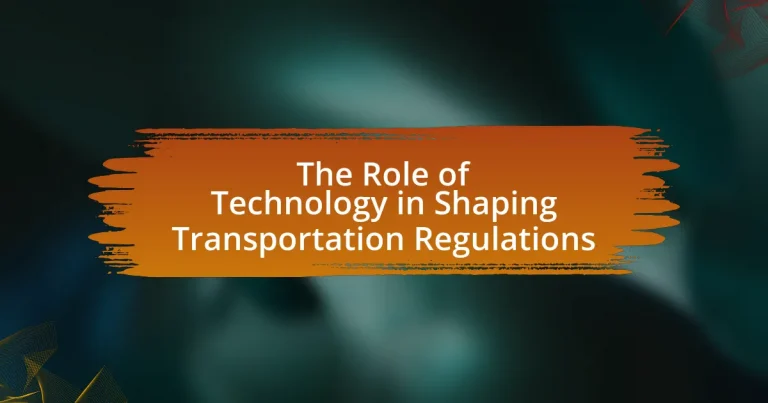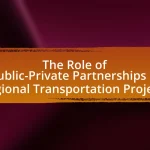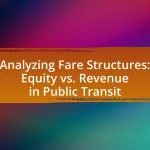The article examines the significant role of technology in shaping transportation regulations, highlighting how advancements such as GPS, telematics, and autonomous vehicles influence regulatory frameworks. It discusses the historical impact of technology on transportation laws, the evolution of regulatory responses to innovations, and the current technologies affecting compliance and safety standards. Key topics include the challenges posed by autonomous vehicles, the importance of data analytics in policy-making, and best practices for integrating technology with regulatory processes to enhance public safety and transparency. The article emphasizes the need for ongoing collaboration among stakeholders to adapt regulations in line with technological advancements.

What is the Role of Technology in Shaping Transportation Regulations?
Technology plays a crucial role in shaping transportation regulations by enabling data-driven decision-making and enhancing safety standards. Advanced technologies such as GPS, telematics, and automated systems provide real-time data that informs regulatory frameworks, allowing for more precise monitoring of vehicle performance and compliance with safety protocols. For instance, the implementation of electronic logging devices (ELDs) has transformed hours-of-service regulations for commercial drivers, ensuring adherence to legal limits and reducing fatigue-related accidents. Additionally, the rise of autonomous vehicles necessitates new regulations that address safety, liability, and operational standards, demonstrating how technological advancements directly influence regulatory adaptations.
How has technology influenced transportation regulations historically?
Technology has historically influenced transportation regulations by introducing innovations that necessitated new safety standards and operational guidelines. For instance, the advent of the steam engine in the 19th century led to the establishment of regulations governing railway safety, including speed limits and signaling systems, to mitigate accidents. Similarly, the introduction of the automobile in the early 20th century prompted the creation of traffic laws, licensing requirements, and vehicle safety standards, such as the Motor Vehicle Safety Act of 1966 in the United States, which aimed to reduce road fatalities. These technological advancements have consistently driven regulatory frameworks to adapt, ensuring public safety and efficient transportation systems.
What key technological advancements have impacted transportation regulations?
Key technological advancements that have impacted transportation regulations include the development of autonomous vehicles, GPS tracking systems, and advanced data analytics. Autonomous vehicles have prompted regulatory bodies to establish new safety standards and liability frameworks, as seen in California’s regulations for self-driving cars. GPS tracking systems have enhanced fleet management and compliance monitoring, leading to stricter enforcement of hours-of-service regulations for commercial drivers. Advanced data analytics enable real-time traffic management and predictive modeling, influencing urban planning and congestion regulations. These advancements necessitate ongoing updates to transportation laws to ensure safety and efficiency.
How have regulatory frameworks evolved alongside technological changes?
Regulatory frameworks have evolved significantly in response to technological changes, particularly in the transportation sector. As innovations such as autonomous vehicles, electric cars, and ride-sharing platforms emerged, regulators adapted existing laws and created new regulations to address safety, liability, and environmental concerns. For instance, the introduction of autonomous vehicles prompted states like California to establish specific testing regulations and safety standards to ensure public safety while fostering innovation. Additionally, the rise of ride-sharing services led to the implementation of new licensing requirements and insurance mandates to protect consumers and drivers. These adaptations demonstrate a proactive approach by regulatory bodies to balance technological advancement with public safety and welfare.
What are the current technologies affecting transportation regulations?
Current technologies affecting transportation regulations include autonomous vehicles, telematics, and blockchain. Autonomous vehicles are reshaping regulations by necessitating new safety standards and liability frameworks, as seen in various pilot programs across the United States. Telematics, which involves the use of GPS and onboard diagnostics, is influencing regulations related to vehicle emissions and driver behavior monitoring, as evidenced by the implementation of smart city initiatives that leverage real-time data. Blockchain technology is enhancing transparency and security in supply chain logistics, prompting regulatory adaptations to accommodate decentralized record-keeping systems. These technologies collectively drive the evolution of transportation regulations to ensure safety, efficiency, and accountability.
How do autonomous vehicles challenge existing transportation regulations?
Autonomous vehicles challenge existing transportation regulations by introducing complexities in liability, safety standards, and operational protocols. Traditional regulations are designed for human-operated vehicles, which complicates the integration of self-driving technology that lacks a human driver responsible for decision-making. For instance, the National Highway Traffic Safety Administration (NHTSA) has had to adapt its guidelines to address the unique safety concerns posed by autonomous systems, such as the need for new testing protocols and performance benchmarks. Additionally, the question of liability in accidents involving autonomous vehicles remains unresolved, as current laws do not clearly define responsibility between manufacturers, software developers, and vehicle owners. This ambiguity necessitates a reevaluation of legal frameworks to accommodate the evolving landscape of transportation technology.
What role does data analytics play in shaping transportation policies?
Data analytics plays a crucial role in shaping transportation policies by providing insights that inform decision-making and optimize resource allocation. Through the analysis of traffic patterns, accident data, and public transportation usage, policymakers can identify trends and areas needing improvement. For instance, a study by the U.S. Department of Transportation found that data-driven approaches to traffic management can reduce congestion by up to 30%, demonstrating the effectiveness of analytics in enhancing transportation efficiency. Additionally, predictive analytics can forecast future transportation needs, allowing for proactive policy adjustments that address emerging challenges.
What are the implications of technology on future transportation regulations?
Technology will significantly influence future transportation regulations by necessitating updates to safety standards, data privacy laws, and environmental policies. As autonomous vehicles and smart transportation systems become prevalent, regulatory frameworks must adapt to ensure public safety and accountability. For instance, the National Highway Traffic Safety Administration (NHTSA) has already begun to establish guidelines for the testing and deployment of autonomous vehicles, reflecting the need for regulations that address new technological capabilities. Additionally, the rise of electric vehicles (EVs) has prompted discussions around emissions regulations and incentives for sustainable practices, as seen in the implementation of stricter emissions standards in various regions. These examples illustrate that technology not only drives innovation in transportation but also compels regulatory bodies to evolve in response to emerging challenges and opportunities.
How might emerging technologies redefine regulatory approaches?
Emerging technologies, such as artificial intelligence, blockchain, and autonomous vehicles, are likely to redefine regulatory approaches by enabling more adaptive, data-driven frameworks. These technologies facilitate real-time monitoring and compliance, allowing regulators to respond swiftly to changes in transportation dynamics. For instance, AI can analyze vast amounts of data to identify patterns and predict safety risks, leading to proactive regulatory measures. Additionally, blockchain can enhance transparency and traceability in supply chains, ensuring accountability among stakeholders. The integration of these technologies into regulatory processes can streamline enforcement and improve public safety, as evidenced by pilot programs in cities like San Francisco, where autonomous vehicle regulations are being adjusted based on real-time data and performance metrics.
What challenges do regulators face in keeping up with technological advancements?
Regulators face significant challenges in keeping up with technological advancements due to the rapid pace of innovation and the complexity of new technologies. The speed at which technologies such as autonomous vehicles, electric transportation, and data analytics evolve often outstrips the regulatory processes, leading to gaps in oversight. For instance, the introduction of autonomous vehicles has raised questions about safety standards and liability, which existing regulations may not adequately address. Additionally, the lack of technical expertise among regulators can hinder their ability to understand and evaluate new technologies effectively. This challenge is compounded by the need for collaboration across multiple jurisdictions, as transportation regulations often vary significantly between regions, making it difficult to implement cohesive policies.
How does technology facilitate compliance with transportation regulations?
Technology facilitates compliance with transportation regulations by automating monitoring and reporting processes. For instance, GPS tracking systems enable real-time location monitoring of vehicles, ensuring adherence to route regulations and speed limits. Additionally, electronic logging devices (ELDs) automatically record driving hours, helping to enforce hours-of-service regulations mandated by the Federal Motor Carrier Safety Administration (FMCSA). These technologies reduce human error and provide accurate data for regulatory compliance audits, thereby enhancing accountability and safety in the transportation sector.
What tools are available for monitoring compliance in transportation?
Tools available for monitoring compliance in transportation include electronic logging devices (ELDs), telematics systems, and compliance management software. ELDs automatically record driving hours and vehicle movement, ensuring adherence to hours-of-service regulations. Telematics systems provide real-time data on vehicle location, speed, and maintenance needs, facilitating compliance with safety and operational standards. Compliance management software helps organizations track regulatory requirements, manage documentation, and conduct audits, ensuring that all aspects of transportation operations meet legal and safety standards. These tools collectively enhance accountability and streamline compliance processes in the transportation sector.
How can technology improve transparency in regulatory processes?
Technology can improve transparency in regulatory processes by enabling real-time data sharing and enhancing public access to information. For instance, blockchain technology allows for immutable records of regulatory compliance, ensuring that all stakeholders can verify transactions and decisions. Additionally, digital platforms facilitate the dissemination of regulatory updates and public comments, fostering greater engagement and accountability. A study by the World Economic Forum highlights that 70% of regulatory bodies using technology report increased public trust due to improved transparency.
What best practices should be considered in integrating technology with transportation regulations?
Best practices for integrating technology with transportation regulations include ensuring compliance with existing laws, fostering collaboration among stakeholders, and prioritizing data security and privacy. Compliance with laws is crucial as it ensures that technological advancements align with regulatory frameworks, preventing legal issues. Collaboration among stakeholders, such as government agencies, technology providers, and transportation companies, facilitates the sharing of insights and resources, leading to more effective regulation. Prioritizing data security and privacy protects sensitive information, which is essential given the increasing reliance on data-driven technologies in transportation. These practices are supported by case studies showing that jurisdictions that adopt a collaborative approach and prioritize compliance and security experience smoother technology integration and improved regulatory outcomes.
How can stakeholders collaborate to enhance regulatory frameworks?
Stakeholders can collaborate to enhance regulatory frameworks by establishing multi-stakeholder partnerships that facilitate information sharing and joint decision-making. These partnerships can include government agencies, industry representatives, and technology developers, allowing for a comprehensive understanding of regulatory impacts and technological advancements. For instance, the U.S. Department of Transportation has engaged with private sector companies to develop guidelines for autonomous vehicles, demonstrating how collaborative efforts can lead to effective regulatory updates that reflect current technological capabilities. This approach not only fosters innovation but also ensures that regulations are adaptable and relevant to emerging trends in transportation technology.
What strategies can be employed to ensure technology aligns with public safety in transportation?
To ensure technology aligns with public safety in transportation, implementing comprehensive regulatory frameworks is essential. These frameworks should include rigorous testing and certification processes for new technologies, such as autonomous vehicles and traffic management systems, to ensure they meet safety standards before deployment. For instance, the National Highway Traffic Safety Administration (NHTSA) has established guidelines for the testing of automated driving systems, which require manufacturers to demonstrate safety through extensive data collection and analysis. Additionally, integrating real-time data analytics can enhance situational awareness for both operators and regulators, allowing for timely responses to potential safety issues. The use of connected vehicle technology, which enables vehicles to communicate with each other and infrastructure, has been shown to reduce accidents by up to 80% in certain scenarios, according to research by the U.S. Department of Transportation. Furthermore, ongoing collaboration between technology developers, transportation agencies, and public safety organizations is crucial to adapt regulations as technology evolves, ensuring that safety remains a priority.


